Introduction
As the year draws to a close, it's time to start thinking about your taxes.
Yes, we know it's not the most exciting topic, but a little planning now can save you a lot of money and stress later.
That's where year-end tax planning strategies come into play. These strategies are like a financial toolkit that can help you reduce your tax bill, maximize your tax deductions, and set yourself up for a smoother tax season.
2024 has brought its fair share of changes to the tax. But don't worry – we've got you covered.
In this article, we'll walk you through ten of the best year-end tax planning tips that can make a real difference to your bottom line.
Our goal is simple — to help you keep more of your hard-earned money in your pocket while staying on the right side of the IRS. Whether you're a seasoned tax pro or just starting to take control of your finances, these tips can benefit everyone.
That said, let’s dive in!
10 Best Year-End Tax Planning Strategies for Individuals
Here are the top 10 year-end tax planning strategies you can leverage to potentially help you save hundreds or even thousands of dollars.
1. Maximize Retirement Contributions
Retirement contribution is one of the most powerful tax-saving strategies of all time.
Maximizing your retirement savings not only sets you up for a more comfortable future but can also significantly reduce your taxable income for the year.
The first and most important retirement contribution you need to make is Individual Retirement Accounts (IRAs).
For 2024, you can contribute up to $6,500 to a traditional or Roth IRA. If you're 50 or older, you get an extra $1,000 as a catch-up contribution.
Traditional IRA contributions are often tax-deductible, meaning they can lower your taxable income for the year. Roth IRA contributions, while not tax-deductible now, grow tax-free and can be withdrawn tax-free in retirement.
If you have a 401(k) or 403(b) through your employer, you're in luck. These plans have even higher contribution limits. For 2024, you can contribute up to $22,500 to these accounts. And if you're 50 or older, you can add an extra $7,500 as a catch-up contribution. That's a total of $30,000 you could potentially shield from taxes this year!
On the other hand, if you’re self-employed, you have options like SEP IRAs or Solo 401(k)s, which often allow for even higher contribution limits based on your income.
Remember, for most retirement accounts, you have until the tax filing deadline (usually April 15th of the following year) to make contributions for the current tax year.
2. Harvest Tax Losses
Now, let's talk about a strategy that can turn your investment losses into a tax advantage: tax-loss harvesting.
It might sound complicated, but it's actually quite simple.
Here's how it works — If you've sold investments at a loss this year, you can use those losses to offset capital gains from other investments. And if your losses exceed your gains, you can even use up to $3,000 of excess loss to reduce your ordinary income.
To start, review your investment portfolio. Look for any stocks, mutual funds, or other securities that have decreased in value since you bought them. These are potential candidates for tax-loss harvesting.
However, you must be aware of a rule called the "wash-sale rule". It basically says that if you sell an investment at a loss and then buy the same or a "substantially identical" investment within 30 days before or after the sale, you can't claim that loss on your taxes.
The IRS is pretty strict about this, so make sure you understand the rule before making any moves.
When you're harvesting losses, think about the big picture of your investment strategy. Don't sell an investment just for the tax benefit if it still fits well in your long-term plan.
And remember, long-term capital gains (from investments held more than a year) are taxed at lower rates than short-term gains, so factor that into your decision-making too.
3. Accelerate Deductions and Defer Income
When it comes to year-end tax planning, timing is everything.
If you strategically time when you receive your income and when you pay for deductible expenses, you can potentially lower your tax bill for the current year.
Let’s simplify this, starting with accelerating deductions. Basically, it means that if you itemize deductions on your tax return, consider paying for deductible expenses before the end of the year.
This could include things like:
- Making an extra mortgage payment to increase your mortgage interest deduction
- Paying your property taxes early
- Scheduling and paying for medical procedures you've been putting off
- Making charitable donations
On the flip side, if you can, try to defer some of your income to next year. If you're expecting a year-end bonus, see if your employer can pay it out in January instead of December.
If you're self-employed, you might delay billing clients so that payments come in next year instead of this year.
Furthermore, if you're planning to make significant charitable donations, consider "bunching" them. This means making two years' worth of donations in a single year to exceed the standard deduction and itemize your deductions.
Remember, the goal here is to lower your taxable income for the current year. But always consider your overall financial situation.
If you expect to be in a higher tax bracket next year, some of these strategies might not make sense for you.
4. Optimize Charitable Giving
Let’s talk about how you can make your generosity work harder for both you and your chosen causes.
First, let’s go over "bunching" your donations, which we touched on earlier.
If your itemized deductions are close to the standard deduction threshold ($13,850 for singles and $27,700 for married couples filing jointly in 2024), consider concentrating two or more years' worth of charitable giving into a single year.
This can push you over the threshold, allowing you to itemize and get a larger deduction.
If you're 70½ or older, you have a special opportunity called Qualified Charitable Distributions (QCDs). With a QCD, you can donate up to $100,000 directly from your IRA to a qualified charity. This donation counts towards your Required Minimum Distribution (RMD) but doesn't increase your taxable income.
Another smart strategy is donating appreciated securities instead of cash. If you have stocks or mutual funds that have gone up in value and you've held them for more than a year, you can donate them directly to a charity.
You'll get a deduction for the full market value of the security and avoid paying capital gains tax on the appreciation.
The charity, being tax-exempt, can sell the security without paying taxes either.
5. Review and Adjust Withholdings
Your withholdings are the amount of money your employer takes out of each paycheck for taxes. If too little is withheld, you could end up with a big tax bill (and possibly penalties) when you file your return.
On the other hand, if too much is withheld, you're essentially giving the government an interest-free loan until you get your refund.
The goal is to get your withholdings just right, so you don't owe much or get much back when you file your taxes.
To do this, you'll want to use the IRS Withholding Calculator. This tool takes into account your income, filing status, and credits and deductions to help you figure out the right amount to withhold.
If you find that you need to adjust your withholdings, you'll need to submit a new W-4 form to your employer.
For those of you who are self-employed or have significant income outside of your regular job, you might need to make estimated tax payments throughout the year. These are typically due quarterly, and it's important to stay on top of them to avoid underpayment penalties.
Remember, major life changes like getting married, having a child, or buying a house can significantly impact your tax situation.
So, it's a good idea to review your withholdings whenever you experience a big life change, not just at the end of the year.
6. Maximize Health Savings Account (HSA) Contributions
If you have a high-deductible health plan, a Health Savings Account (HSA) can be a powerful tool in your tax-saving toolkit.
HSAs offer a triple tax advantage: contributions are tax-deductible, the money grows tax-free, and withdrawals for qualified medical expenses are tax-free too.
For 2024, you can contribute up to $3,850 for individual coverage or $7,750 for family coverage.
If you're 55 or older, you can add an extra $1,000 as a catch-up contribution. These limits include both your contributions and any contributions your employer makes.
One of the best things about HSAs is that, unlike Flexible Spending Accounts (FSAs), the money rolls over from year to year. There's no "use it or lose it" rule. This means you can use your HSA as a long-term savings vehicle for future medical expenses.
In fact, many financial experts recommend maximizing your HSA contributions even if you can afford to pay for current medical expenses out-of-pocket.
Why? Because you can invest the money in your HSA, potentially allowing it to grow over time.
Some HSA providers offer a range of investment options, similar to what you might find in a 401(k).
Think of it this way — by maxing out your HSA and investing the funds, you're essentially creating a separate retirement account for healthcare expenses. And given that healthcare is often one of the largest expenses in retirement, this can be a very smart long-term strategy.
Just remember to keep good records of your medical expenses, even if you pay for them out-of-pocket now.
You can reimburse yourself from your HSA for these expenses at any time in the future, as long as the expense occurred after you established the HSA.
7. Consider Roth IRA Conversions
As we approach the end of the year, it's a good time to think about whether a Roth IRA conversion might make sense for you.
This strategy involves moving money from a traditional IRA (where contributions are often tax-deductible, but withdrawals are taxed) to a Roth IRA (where contributions are made with after-tax dollars, but qualified withdrawals are tax-free).
Why would you do this? Well, if you believe you'll be in a higher tax bracket in retirement, paying taxes on the money now at a lower rate could save you money in the long run. It's also a way to reduce your future Required Minimum Distributions (RMDs), as Roth IRAs don't have RMDs during the owner's lifetime.
However, there are some important factors to consider before converting:
You'll owe taxes on the amount you convert. This could push you into a higher tax bracket for the year, so it's crucial to plan carefully.
It's generally best to pay the taxes due on the conversion with money from outside the IRA. If you use IRA funds to pay the tax, you'll lose out on potential tax-free growth on that money.There's a five-year rule for Roth IRA withdrawals. You must wait five years after the conversion to withdraw the converted amount penalty-free, even if you're over 59½.
For high-income earners who aren't eligible to contribute directly to a Roth IRA, there's a strategy called the "backdoor Roth IRA." This involves making a non-deductible contribution to a traditional IRA and then immediately converting it to a Roth.
It's a bit complex and there are some potential pitfalls, so it's best to consult with a financial advisor if you're considering this strategy.
Remember, the decision to do a Roth conversion should be based on your individual financial situation and long-term goals. It's not right for everyone, but for some, it can be a powerful way to manage taxes in retirement.
8. Take Required Minimum Distributions (RMDs)
If you're over 73 (as of 2024) and have money in traditional IRAs or other qualified retirement plans, you need to know about Required Minimum Distributions (RMDs).
These are mandatory withdrawals the IRS requires you to take each year, and forgetting about them can result in hefty penalties.
The age at which RMDs must begin has changed recently. If you turned 72 after December 31, 2022, you must begin taking RMDs in the year you turn 73.
On the other hand, if you turned 72 in 2022 or earlier, you should already be taking RMDs.
The amount you need to withdraw each year is calculated based on your account balance at the end of the previous year and your life expectancy according to IRS tables. Your financial institution can usually help you calculate this amount, or you can use the worksheets provided by the IRS.
It's crucial to take your RMD by the deadline, which is generally December 31st each year. (There's an exception for your first RMD, which can be delayed until April 1st of the year following the year you turn 73.) If you miss the deadline, the penalty is steep – 25% of the amount you should have withdrawn.
If you have multiple IRAs, you can calculate the RMD for each account separately, but you can withdraw the total amount from one or any combination of your IRAs. For 401(k)s and other employer plans, you generally must calculate and take RMDs separately for each account.
One strategy to consider if you don't need the income from your RMD is a Qualified Charitable Distribution (QCD).
As mentioned earlier, if you're 70½ or older, you can donate up to $100,000 directly from your IRA to a qualified charity. This counts towards your RMD but isn't included in your taxable income.
Remember, RMDs are just minimums. You can always withdraw more if you need to. But be mindful of how these withdrawals might affect your overall tax situation.
9. Utilize Education Savings Plans
If you're saving for education expenses – whether for your children, grandchildren, or even yourself — there are some tax-advantaged options you should know about.
First up is the 529 plan. These plans allow you to save for education expenses, and the money grows tax-free.
Withdrawals are also tax-free when used for qualified education expenses. While contributions to 529 plans aren't deductible from your federal taxes, many states offer tax benefits for contributions.
For 2024, you can contribute up to $17,000 per beneficiary to a 529 plan without triggering gift tax consequences. There's also a special rule that allows you to front-load five years of contributions at once, for a total of $85,000 per beneficiary.
Another option is the Coverdell Education Savings Account (ESA). These accounts offer more investment flexibility than most 529 plans, but they have lower contribution limits – just $2,000 per beneficiary per year. Also, there are income limits on who can contribute to Coverdell ESAs.
If you or your child is currently in college, don't forget about education tax credits. The American Opportunity Tax Credit can provide up to $2,500 per eligible student for the first four years of higher education.
The Lifetime Learning Credit can provide up to $2,000 per tax return for undergraduate, graduate, and professional degree courses.
Lastly, if you're repaying student loans, you can deduct up to $2,500 of student loan interest paid during the year, depending on your income.
Remember, while these education savings strategies can offer significant tax benefits, it's important to balance them with your other financial goals, like saving for retirement.
10. Review Estate and Gift Tax Strategies
As we round out our list of year-end tax planning strategies, let's talk about estate and gift tax planning.
While this might seem like a concern only for the very wealthy, recent changes in tax laws have made it relevant for more people.
First, let's look at gifting. For 2024, you can give up to $17,000 per person per year without triggering gift tax consequences. This is known as the annual gift tax exclusion. If you're married, you and your spouse can each give $17,000 to the same person, effectively doubling the amount.
This strategy can be particularly useful if you're trying to reduce the size of your estate for estate tax purposes. Remember, these gifts don't have to be cash – they could be shares of stock, real estate, or other valuable assets.
Speaking of estate taxes, it's important to be aware of the lifetime estate and gift tax exemption.
For 2024, this exemption is $12.92 million per individual. This means you can give away up to this amount during your lifetime or at death without owing federal estate taxes. Married couples can effectively double this amount.
However, be aware that this high exemption amount is set to expire after 2025, potentially dropping to around half its current level. This makes now a good time to consider strategies for reducing your estate tax liability, such as setting up irrevocable trusts or making large gifts.
Another thing to consider is the generation-skipping transfer (GST) tax. This tax applies to transfers made to grandchildren or more remote descendants.
The GST tax exemption is the same as the estate tax exemption, but it requires careful planning to be used effectively.
Estate planning can be complex, so it's often worth consulting with an estate planning attorney or tax professional to ensure you're making the most of the available strategies while complying with all relevant laws.
Conclusion
While these year-end tax planning strategies provide a solid foundation, it's important to recognize that every financial situation is unique.
What works wonders for your neighbor might not be the best fit for you.
That's where professional guidance can make all the difference.
At Virtue CPA, we understand that effective tax planning goes beyond just filling out forms. It's about creating a comprehensive strategy that aligns with your personal goals and sets you up for long-term financial well-being.
Our team of experienced CPAs stays up-to-date with the latest tax laws and regulations, ensuring that you're always taking advantage of every available opportunity.
We don't just apply a one-size-fits-all approach. Instead, we take the time to understand your unique situation, helping you navigate the complexities of the tax code with confidence.
With Virtue CPA by your side, you're not just planning for this year's taxes – you're building a robust financial future. We'll help you implement the strategies we've discussed in this article and introduce you to additional tactics that might benefit your specific circumstances.
FAQs
You can claim tax breaks such as child tax credit, child and dependent care credit, American opportunity tax credit, lifetime learning credit, student loan interest deduction, adoption credit, earned income tax credit, charitable donation deduction.
Tax write-off is a term used for tax deduction. However, it is neither used by IRS nor mentioned in the Internal Revenue Code.
A tax write-off reduces your taxable income, which lowers the amount of tax you owe. It enables individuals or businesses to deduct certain expenses from their total income before calculating taxes.
For instance, you can deduct expenses like medical expenses, donations, or mortgage interest, or as a business owner, you can write off expenses such as rent, utilities, or office supplies.
To qualify for a write-off, you need to record and report these expenses on your tax return, along with any necessary documents. It's also important to ensure that the deductions comply with tax laws.
Tax rebate is the informal term used when tax amount is reduced because of the updated tax laws.
When you pay more taxes than you owe for the year, you get a refund called a tax rebate. This happens when the total taxes paid through estimated payments, deductions, or other credits is greater than what you owe. In these cases, the IRS gives back the extra amount to you.






